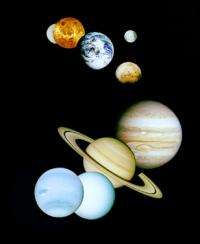STAR TRAK for November

(PhysOrg.com) -- Jupiter will be easy to see in the east as night falls in November. The bright planet was at opposition on Oct. 29, so during November it will still be visible almost all night at its maximum brilliance. This is when you can get good telescopic views of Jupiter without staying up late, as it travels high across the sky from southeast to southwest. Jupiter's four brightest moons will be visible with binoculars.
Venus will continue low in the southwest on November evenings, appearing about 15 minutes after sunset and setting more than an hour later.
Mercury will be about 2 degrees below Venus for the first half of the month, becoming visible with the unaided eye about a half hour after sunset. After midmonth, Venus will move higher while Mercury drops back toward the horizon, disappearing into the glow of twilight.
Mars will rise around 1 a.m. daylight saving time at the start of November but before midnight standard time by month's end. The red-orange planet will pass close above the blue-white star Regulus in the constellation Leo the Lion on the night of Nov. 10-11. Look about halfway up the southeastern sky to see these two bright objects close together during most of November.
Saturn will rise in the east around 6 a.m. local time at the beginning of November and about 3:30 a.m. by the end of the month. The yellow planet will be slightly brighter than the bright white star Spica below it. During November the tilt of Saturn's rings to our line of sight will increase to almost 14 degrees.
Meteor shower
The annual Leonid meteor shower will peak on the night of Nov. 17-18. This year the third-quarter moon will be near the shower's radiant in the constellation Leo the Lion. In an otherwise dark sky, about 10 meteors per hour may be visible. To see the most meteors, get away from city lights and face away from the moon's glare. The bright star Regulus is part of Leo and can serve as a marker for the radiant, the point from which the meteors will appear to come. The farther sickle-shaped Leo climbs above the eastern horizon, the more meteors there will be all over the sky. The Leonid meteors are caused by streams of fast-moving dust particles from Comet Tempel Tuttle.
More information about meteor showers is available from the American Meteor Society at www.amsmeteors.org/showers.html.
Moon phases
The moon will be at first quarter on Nov. 2, full on Nov. 10, at third quarter on Nov.18 and new on Nov. 25.
Provided by Indiana University





















